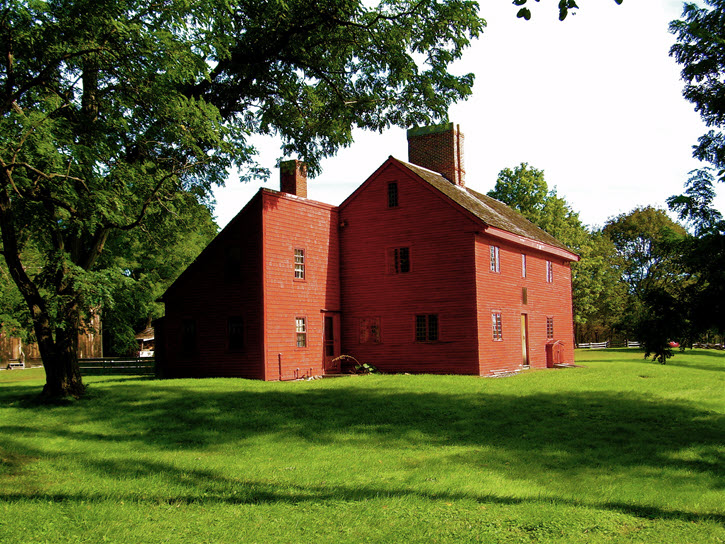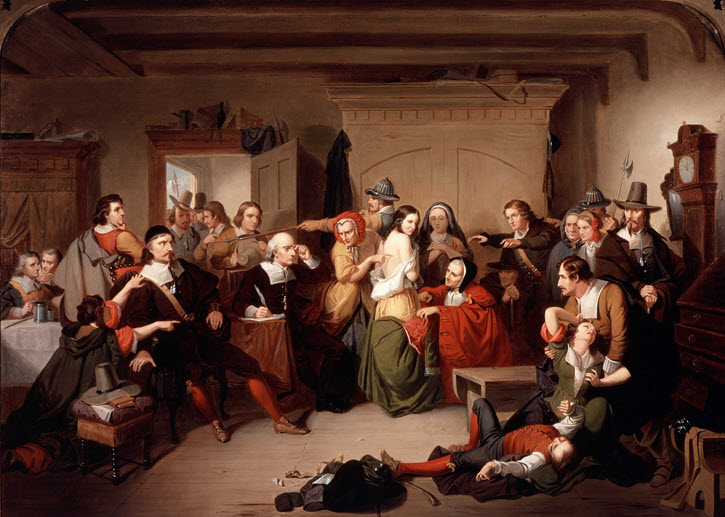Rebecca Nurse, A Salem Witch
While there is no evidence to suggest any connection to my ancestors, it is interesting to look at some of the people through the ages who have carried the name Noers, Norreys, Norris or Nurse.
In this article I look at Rebecca Nurse – perhaps the most (in)famous person to carry the surname.
It is ironic that one of the more famous Norrises was Edward Norris the Pastor of Salem Church during the 1640s and 1650s, as perhaps the most famous (or infamous) person to carry the name Nurse was Rebecca (Towne) Nurse, who was hanged as a witch during the “Witch Hysteria” of the 1690’s in the very same New England town.
She was living in Salem during the last 20 years of Edward Norris’ life and may well have known him quite well. Her story is well known, and has been written in many historical and fictionalized accounts of the trials, including Arthur Miller’s play “The Crucible” and the movie “Three Sovereigns for Sarah”.
Rebecca Towne was baptized at Yarmouth, England, on February 21st, 1621/22, the daughter of William Towne and Joanna Blessing. She came to Salem with her family in 1640.1 In about 1645,2 she married Francis Nurse, who was born in England between 1618 and 1620. Francis was a tray maker who probably also made other wooden household items. (see “Rebecca Nurse” 2023)
The couple had eight children, four sons and four daughters. In 1672 Francis served as Salem’s constable. In 1678 the family were offered to lease to own a 300-acre farm in what is today Danvers. Francis built a house on the land (Perley 1928, 3:113), which is still standing today and is know as the “Rebecca Nurse Homestead”. In 1699 the children were able to buy the title to the house outright, and it remained in the family for many generations(Figure 1)3.

In 1692, the Salem Village was racked with a “witchcraft delusion” (Perley 1928, 3:254–95). Rebecca was a 71-year-old invalid who had raised a family of eight children. The Nurse family had been involved in several land disputes, which could have caused ill feeling among some of the residents of Salem. Nevertheless, most of her contemporaries sympathized with her. The dignity and nobility of her character, which she showed throughout the trials undoubtedly, helped, turn public opinion against the trials.
Soon after the first of the women had been accused of witchcraft, Rebecca Nurse discovered that her name had also been mentioned as a suspect. She is reported to have said
“I am innocent as the child unborn, but surely, what sin hath God found out in me unrepented of that He should lay such an affliction on me in my old age.”4
On March 23rd, 1692 a warrant was issued for her arrest upon the complaint of Edward and John Putnam. (The Putnam family was among those that had been involved in land disputes with Rebecca and her husband.) Thirty-nine of the most prominent members of the community signed a petition on her behalf.
Rebecca was indicted on June 2nd and subjected to a physical examination by a jury of women. They found what a majority of them believed to be a mark of the devil – although two of the women disagreed, saying the mark was due to natural causes. Rebecca asked that others examine her before she was brought to trial, but the request was denied.
The trial began on June 30th, 1692. Her accusers included the four young girls who initiated the witchcraft hysteria in Salem, Rev. Parris and several members of the Putnam family. Rebecca’s son, son-in-law and daughter-in -law spoke in her defense.
As in other cases, Rebecca’s examination by judges was accompanied by great noyses by the afflicted. She repeated her assertion that she was innocent but was committed to the Salem jail. Needless to say, the procedure was a travesty of justice. Belief in witchcraft was widespread in New England at that time, but even in that climate it is surprising that convictions could occur as a result of hearsay, slander and hysteria. (see Figure 2 for an example of a Witch Trial)5

The jury at first returned a verdict of “not guilty”. Some who had been accused, confessed to practicing witchcraft in hopes that their death sentences would be dropped. One of these women, Goody Hobbs, had muttered, “she is one of us”. In light of this the judge asked that the verdict be reconsidered. When Rebecca was asked what Goody Hobbs had meant, she didn’t answer. Later she said that she had not heard the question, as she was hard of hearing, and that “one of us” had meant that they were imprisoned together. The Governor granted a reprieve, but when Rebecca’s accusers renewed their outcry it was withdrawn.6
On July 3rd, Rebecca Nurse was excommunicated – “abandoned to the devil and eternally damned”. On July 19th she was driven in a cart with four other women to Gallows Hill where she was hanged. Tradition says that at midnight Francis Nurse, his sons and sons-in-law found Rebecca’s body in the common grave where it had been flung and carried it home for a proper burial.7
One of Rebecca’s sisters, Mary (Towne) Estey, was also hanged on charges of being a witch. The last of the executions in Salem took place in September 1692. In all, 20 people were put to death (including five men), and eight others died in jail.
The trials ended perhaps because too many people of good reputation had been accused.8 By 1703 the General Court made payments to the heirs of the victims and 25 pounds was paid to the heirs of Rebecca Nurse.
In 1706, Ann Putnam, one of the original four hysterical young women, made a written statement of remorse. She said that the devil had deceived her into accusing innocent people and mentioned “Goodwife Nurse” in particular.
In 1712 the pastor who had cast Rebecca out of the church formally canceled the excommunication.
Francis Nurse survived until November 22nd, 1695. The house where he and Rebecca lived still stands and is maintained by an historical society.
References
Perley, Sidney, ed. 1926. The History of Salem, Massachusetts. Vol. 2. Salem: Sidney Perley. https://archive.org/details/historyofsalemma02perl/mode/1up.
———, ed. 1928. The History of Salem, Massachusetts. Vol. 3. Salem: Sidney Perley. https://archive.org/details/historyofsalemma03perl/mode/1up.
“Rebecca Nurse.” 2023. Wikipedia; Wikimedia Foundation. 2023. https://en.wikipedia.org/w/index.php?title=Rebecca_Nurse&oldid=1154643243.
Tapley, Charles Sutherland, ed. 1930. Rebecca Nurse: Saint but Witch Victim. Boston, Massachusetts: Marshall Jones Company.
Footnotes
-
On October 11th 1640, her father, William Towne, was given a grant of land (see Perley 1926, 2:p108)↩
-
(see “Rebecca Nurse” 2023)↩
-
Attribution to Willijay CC BY-SA 3.0 (https://creativecommons.org/licenses/by-sa/3.0/deed.en/)↩
-
(see Tapley 1930, 47)↩
-
The Examination of a Witch (1853), depicting the trial of Quaker preacher Mary Fisher in 1656. Oil on canvas, 97.8 x 137 cm (38.5 x 53.9 in).↩
-
(see Tapley 1930, 65.)↩
-
(see Tapley 1930, 68.)↩
-
(see Tapley 1930, 83.)↩